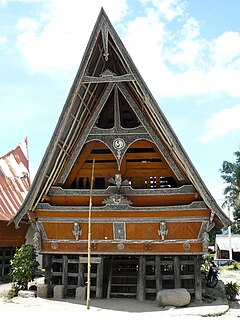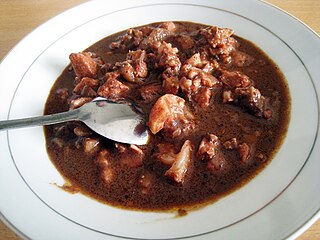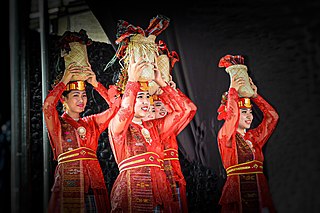The Batak script is a writing system used to write the Austronesian Batak languages spoken by several million people on the Indonesian island of Sumatra. The script may be derived from the Kawi and Pallava script, ultimately derived from the Brahmi script of India, or from the hypothetical Proto-Sumatran script influenced by Pallava.

Batak is a collective term used to identify a number of closely related Austronesian ethnic groups predominantly found in North Sumatra, Indonesia who speak Batak languages. The term is used to include the Karo, Pakpak, Simalungun, Toba, Angkola, and Mandailing which are related groups with distinct languages and traditional customs (adat).

The Batak are one of about 140 indigenous peoples of the Philippines. They are located in the northeastern portions of Palawan, a relatively large island in the southwest of the archipelago. Since ancient times, the Batak have inhabited a series of river valleys along the coastline of what is today Puerto Princesa City.

Singa is an apotropaic figure from the mythology of the Batak people of North Sumatra, Indonesia. The singa represents a benevolent and protective power. The singa is described as "part human, part water buffalo, and part crocodile or lizard". It is variedly represented, but always has an elongated face, with big bulging eyes, a well-defined nose, and long spiralling beard. It is often represented only with its head, but sometimes it may also be represented full body. Other figures - such as other protective deity or ancestral figures - may also be represented standing or sitting on top of the head of the singa.

The Huria Kristen Batak Protestan (HKBP), which translates into English as the Batak Christian Protestant Church, is the largest Lutheran church in Indonesia, and one of the largest traditional churches in Indonesia and one of the largest churches in Southeast Asia, with a baptized membership of 4,500,000. Its present leader is Ephorus (Bishop) Robinson Butarbutar.

The Batak languages are a subgroup of the Austronesian languages spoken by the Batak people in the Indonesian province of North Sumatra and surrounding areas.
The term Parmalim or malim describes the followers of the Malim religion, the modern form of the traditional Batak religion. People who are not familiar with the Batak language may erroneously assume Parmalim is the name of the religion rather than its practitioners.

Toba Batak is an Austronesian language spoken in North Sumatra province in Indonesia. It is part of a group of languages called "Batak".

Karo, referred to in Indonesia as Bahasa Karo, is an Austronesian language that is spoken by the Karo people of Indonesia. It is used by around 600,000 people in North Sumatra. It is mainly spoken in Karo Regency, southern parts of Deli Serdang Regency and northern parts of Dairi Regency, North Sumatra, Indonesia. It was historically written using the Batak alphabet which is descended from the Brahmi script of ancient India by way of the Pallava and Old Kawi scripts, but nowadays only a tiny number of Karo can write or understand the script, and instead the Latin script is used.

The Simalungun people are an ethnic group in North Sumatra, considered one of the Batak peoples. Simalungun people live mostly in Simalungun Regency and the surrounding areas, including the city of Pematang Siantar, an autonomous city, but previously part of Simalungun Regency.

Arsik is an Indonesian spicy fish dish of the Batak Toba and Mandailing people of North Sumatra, usually using the common carp.

Toba people also referred to as Batak Toba people are the largest group of the Batak people of North Sumatra, Indonesia. The common phrase of ‘Batak’ usually refers to the Batak Toba people. This mistake caused by the Toba people being the largest sub-group of the Batak ethnic and their differing social habit to self-identify as merely Batak instead of ‘Toba’ or ‘Batak Toba’, contrary to the habit of the Karo, Mandailing, Simalungun, Pakpak communities who commonly self-identified with their respective sub-groups.

Batak architecture refers to the related architectural traditions and designs of the various Batak peoples of North Sumatra, Indonesia. There are six groups of Batak who speak separate but related languages: the Angkola, the Mandailing to the south, the Toba, to the north the Pakpak/Dairi, the Simalungun, and the Karo. While the groups are now Muslim or Christian, elements of the ancient Batak religion remain, particularly amongst the Karo.

Saksang or sa-sang is a savory, spicy Indonesian dish from the Batak people. It is made from minced pork or dog meat stewed in its blood, coconut milk and spices; including kaffir lime and bay leaves, coriander, shallot, garlic, chili pepper and Thai pepper, lemongrass, ginger, galangal, turmeric and andaliman.
Batak is an Austronesian language spoken by the Batak people on Palawan Island in the Philippines. It is sometimes disambiguated from the Batak languages as Palawan Batak.
Manuk Napinadar or Chicken Napinadar is typical Batak cuisine in Indonesia that is usually served at certain customary feasts.

Batak cuisine is the cuisine and cooking traditions of Batak ethnic groups, predominantly found in Northern Sumatra region, Indonesia. Batak cuisine is part of Indonesian cuisine, and compared to other Sumatran cuisine traditions, it is more indigenously preserved. One characteristic of Batak cuisine is its preference to andaliman as the main spice. That is why andaliman in Indonesia sometimes dubbed as "Batak pepper".

Gorga is a form of artistic decoration found in the culture of Batak Toba in North Sumatra, Indonesia. The gorga motif is in the shape of flourishes and undulations. The motif is either painted or carved onto wood using three colors: white, red, black; each corresponds with different realms in the Batak Toba cosmology. Gorga motif is often found in Batak Toba architecture e.g. a Batak Toba house or objects e.g. music instruments. They are meant to protect the building or object from spiritual harm e.g. evil spirits sent from neighboring village.

Mie Gomak is a Batak thick spicy noodle soup dish served in a coconut milk and andaliman-based broth, specialty of Toba Batak region of North Sumatra, Indonesia. Other that traditional Batak lands surrounding Lake Toba, this dish is also a specialty of the Sibolga and Tapanuli area. Unlike common Indonesian noodles, the type of noodle used in this dish is a thick one called mie lidi, quite similar to spaghetti pasta, thus mie gomak is often described as Batak style spaghetti. Mie gomak is quite similar to Mie Aceh from neighbouring province.

Tandok dance is a traditional Batak dance originating from the North Sumatra, Indonesia. This dance tells about the activities of harvesting rice using tandok carried out by mothers in the fields. In addition, this dance also contains the importance of family values between each other.














